Knitting clothes for children under one year is a good alternative to high prices for baby clothes. This will save parents money, and the clothes will be exclusive.
Requirements for knitted products for children under one year
During the first year of life, the child grows very quickly, so it is necessary to buy new clothes for the baby almost every week. Knitted items can be made 1-2 sizes larger, and they do not lose their attractiveness when worn.
Size
Knitting things for children under one year is difficult only in choosing the right size. While clothes are being made for the current size, the child will grow up and the new thing will be too small for him.
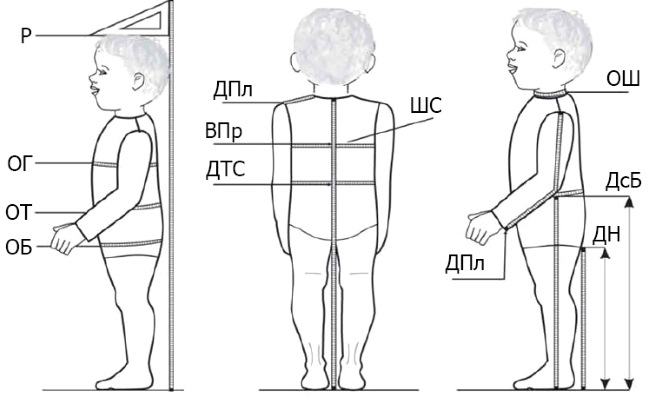
If the height is 50 cm (at birth), it is worth adding 5-10 cm so that by the time the product is ready, it will be just right or slightly larger.
Yarn
The variety of threads is now huge, but not every one is suitable for making children's clothing, especially for newborn babies:
- Knitting for children under one year of age from wool yarn is best done with a thread made from merino wool. Such yarn is softer and warmer than other types.
- Cotton yarn is considered hypoallergenic. It can be used to knit items for any season.
- Acrylic thread is synthetic and does not have good thermoregulatory properties. But it is still used for knitting children's things. There are several types of acrylic, when buying you need to choose a children's line, as it is softer.

- Semi-wool is a yarn consisting of acrylic thread and wool. There are different percentage ratios of the composition. Preference should be given to skeins where wool is 25-50%. It is soft and does not prickle.
- Semi-cotton is a combination of acrylic and cotton threads. There are many manufacturers of such yarn, but you should choose a composition with a 50x50% thread ratio for knitting clothes for children under one year. Such yarn is pleasant to the touch.
Pattern, knitting density
The knitting density of children's clothes is calculated not in centimeters, but in the number of loops. A line of 48 cm contains 98 loops: 96 main loops, as well as 2 edge loops. To make a fabric measuring 20 by 30 cm, you will need to cast on 46 loops on the knitting needles. They must be knitted in 75 rows. To calculate the density of loops in each item of clothing. You need to understand how many of them fit in 1 cm2.
The following number of loops fit into 1 cm of medium-thick thread:
- Wool, semi-wool, acrylic – 1.5-2;
- Semi-cotton and cotton – 2-3.
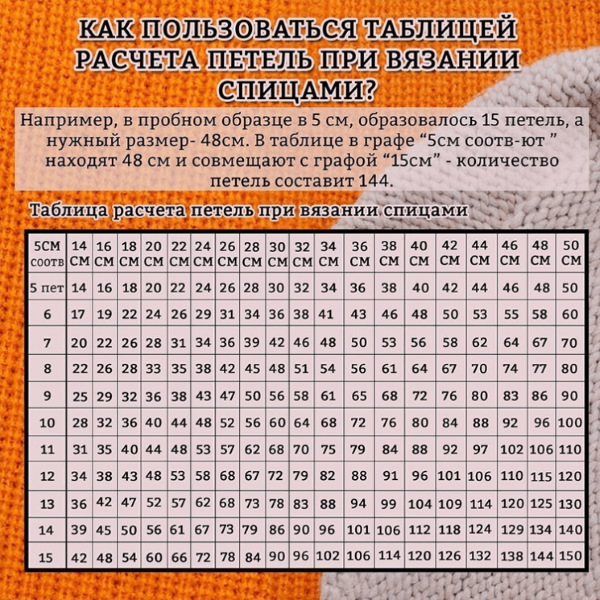
To find out the exact number, you should cast on an approximate number of loops and knit the first row. After that, you need to measure the distance from the beginning of knitting to the 1 cm mark, then multiply by the required number in centimeters and add 2 loops (edge).
Patterns
Knitting for children under one year of age with simple patterns is the best option. They do not create strong relief, and the child is comfortable in such clothes.
Suitable pattern options:
- "Checkers". The pattern is also called "Squares". The pattern is knitted with purl and face groups of loops. Calculation for the pattern: on the knitting needle - 52 loops. 2 edge and 50 working. From them you will get 10 squares with 5 loops. You need to knit 5 purl, then 5 face, then purl loops again and so on until the end of the row. Turn the work over.
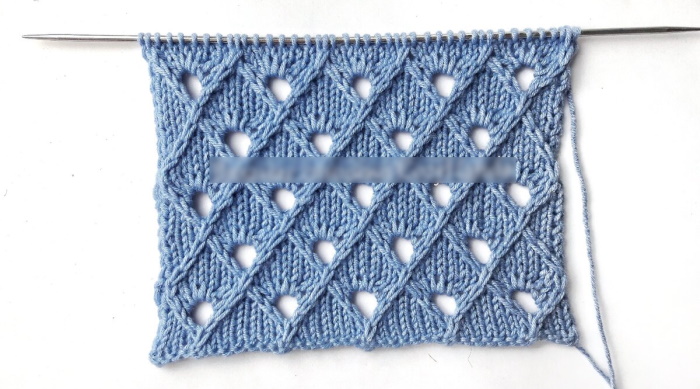
If the last square was made of face loops, they are knitted as purl, and the purl ones are knitted as face loops. To get a square, you need to knit 5 rows, and then shift the groups. The first ones will be face loops. If you knit more rows, you will get a pattern of "vertical rectangles-checkers"
- "Rhombus". The pattern is knitted in the same way - in groups. 5 front loops, 1 back loop. The next 2 rows are knitted taking into account the decrease and increase in each group of 2 loops.
- "Garret stitch". The knitting pattern is very simple. Perform a row of face loops, a row of purl. You can add a small patterned fragment in the form of a heart or a diamond in the central part.
- "Rubber". The pattern is knitted simply: 2 front loops, then 2 back loops. Alternating pairs to the end of the row. This pattern is most often used to knit scarves, bibs and hats.
Useful information! You can choose any patterns, the main thing is that the thread is chosen correctly. Otherwise, the child will experience discomfort and friction when wearing clothes.
Seams
In principle, there should be no seams in children's clothing for babies under one year old, or they should be external. They need to be sealed carefully so that they do not turn out voluminous. A child at this age moves a lot, so thick seams can lead to skin injuries.
When inserting elastic into a sleeve seam, the bottom of pants or booties, you need to check first: will it not pinch the child's arms and legs. When knitting a hat, it is better to choose options with seamless patterns. On such products, the seams can press on the head, which can lead to deformation of the baby's skull.
Children's clothing size charts
Sizes of sweaters, pants, dresses and overalls:
| Child's age, months | Height, cm |
| 0-3 | 50-56 |
| 4-6 | 62-68 |
| 7-9 | 74-80 |
| 9-12 | 86-98-104 |
Headwear is also divided by size:
| Child's age, months | Head circumference, cm |
| 0-3 | 36-38 |
| 4-6 | 39-41 |
| 7-9 | 42-44 |
| 9-12 | From 45 |
Sizes of booties and socks:
| Child's age, months | Size, cm |
| 0-3 | 8-9 |
| 4-6 | 9-10 |
| 7-9 | 10-11 |
| 9-12 | From 11 |
Step-by-step description of knitting clothes for children under one year old with knitting needles
Knitting for children under one year old can be mastered by any mother. The article describes several patterns of clothing models for beginners in needlework.
Headdress
You can use 2 pattern options, suitable for boys and girls. All that remains is to choose the color for making hat models.
Summer option
To make a headdress, you will need circular knitting needles with number 3 (they are connected with a fishing line), as well as acrylic yarn. The thread should be narrow or medium thick. This pattern can also be used to make hats for the cold season. For knitting, you should take warmer yarn - wool or semi-wool.
Knitting algorithm:
- You need to cast on 80 stitches.
- The elastic is knitted according to the 1x1 pattern (one purl, one front loop) - 5 rows. The height of the elastic can be adjusted independently.

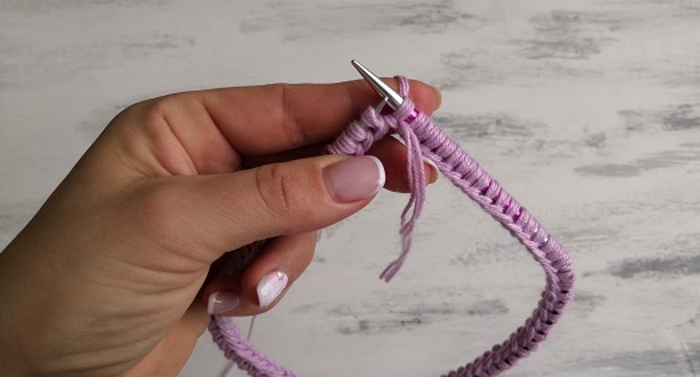


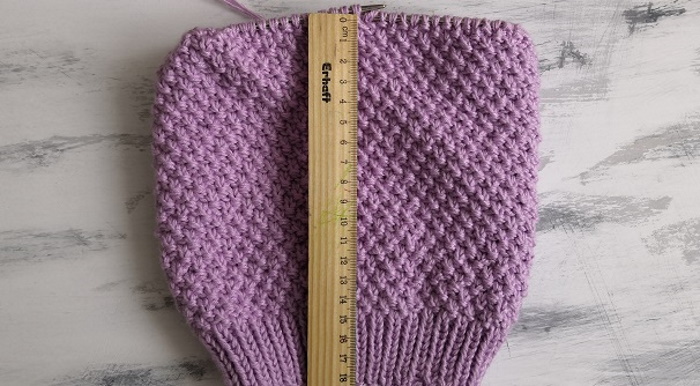
- The main fabric is knitted with a "Pearl pattern": according to the elastic pattern, but in a checkerboard pattern. In each subsequent row, the front loops are replaced by back loops, and back loops are replaced by front loops. So it is necessary to knit 41 rows (the height of the main fabric is measured individually).
- Now you need to fold the product in half, determine the side sides. On them you will need to knit 2 loops together (front) in each even row, starting from 42.
- There should be 12 loops left on the needles. They are closed together. To do this, pull the thread through them and tighten, securing with a double knot. The ends of the thread are hidden inside the hat.
Winter version
To work you will need circular knitting needles with number 2, as well as yarn (wool or semi-wool) of 2 colors.
Note! Depending on the type of yarn and the thickness of the knitting needles, you can knit warm hats for the winter or autumn season using the pattern. By replacing the knitting needles with number 1-1.5 and the yarn with acrylic or semi-cotton, you will get an excellent headdress for the summer.
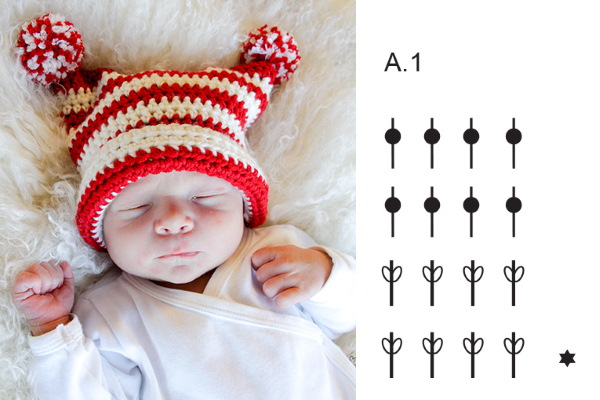
Algorithm for performing work:
- You need to cast on 80 working loops onto the knitting needles.
- The first 5-6 rows are knitted using a 1x1 elastic pattern.
- The working fabric (counting starts from row 1) is knitted as follows:
- odd rows – 1 knit, 1 purl stitch;
- even - all loops are knitted.
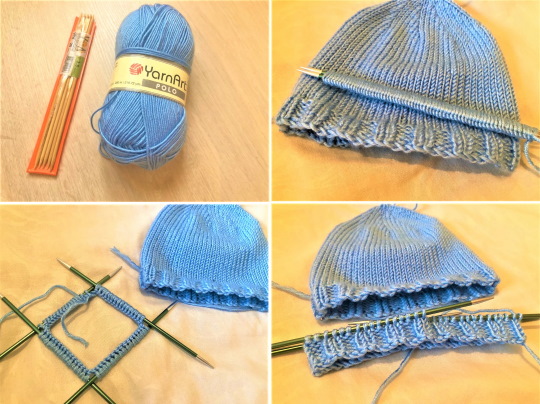
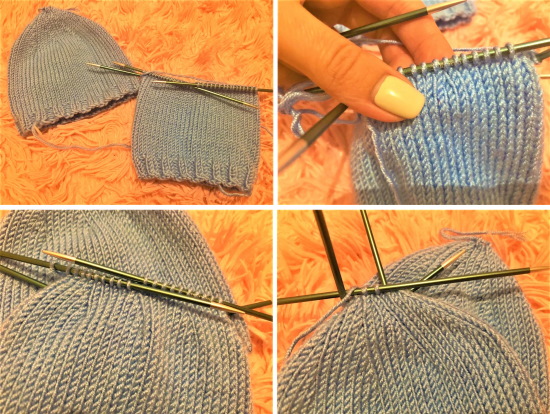
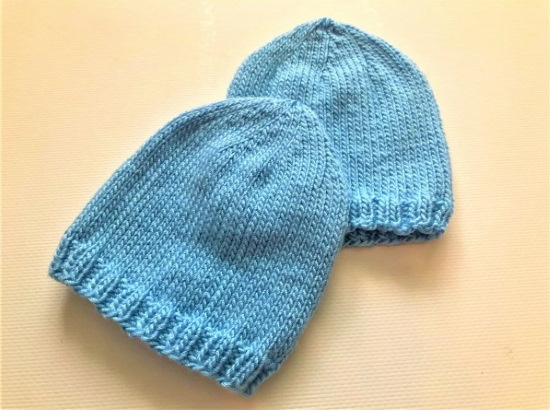
- 7 rows of the main fabric are knitted, then the color is changed and so on every 7 rows.
- When the main knitting is 12 cm long, the working thread is changed to the same color as the elastic band, and a few more rows are knitted to the desired height.
- The work is folded in half. In the side parts, decrease by 1 loop on each side. Double loops are knitted as front loops.
There should be 12 loops left on the needles.
There are 2 ways to close them:
- tighten all the loops at once with thread;
- Divide stitches (non-circular) onto 2 needles and bind off in pairs using the 3rd needle or a large pin.
Knitting hats with ears for children under one year old looks better if you close the work according to the second option, and according to the first option it is better to complement the product with a shaggy pompom or flower.
Socks
Seamless socks for newborns are best knitted on a set of 5 knitting needles. For work you will need tools with number 3 for a warm product or 1-1.5 for making summer socks. It is also better to take a medium-thickness thread (acrylic, wool, semi-wool) for the warm season. For summer you can take a thinner thread (cotton or acrylic).
Knitting instructions:
- Cast on 28 stitches (if the socks are winter) or 32 (for summer).
- Having knitted 1 row according to the 1x1 pattern (rib), distribute the loops evenly across 4 knitting needles. Close the circle by pulling the thread through 1 loop. The extra loop is knitted with the last one. You can cast on an additional loop for closing. When distributing the loops, it will decrease.
- Knit a high elastic band - 10 rows (for a simple sock) or 20 (with an elastic band turn-up).
- The next 6 rows are knitted only with front loops.
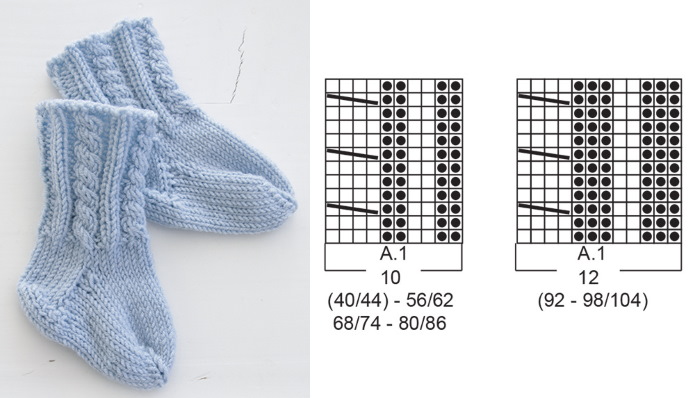
- Needles 3 and 4 are fixed. Work continues on needles 1 and 2. For convenience, the loops are transferred to 1 needle.
- Knitting continues for 6 rows while maintaining the pattern.
- The number of loops is divided by 4/6/4.
- Knitting continues with all working needles. The separated 4 loops are knitted together with the last loops, which are located on the previously left needles. The 6 central loops are knitted as front loops, like the other loops in the circle.
- In the corners of the heel, add loops to the 4th knitting needle. Each of them should now have 6 loops.
- Next, the sock is knitted with the same front loops – 10-12 rows.
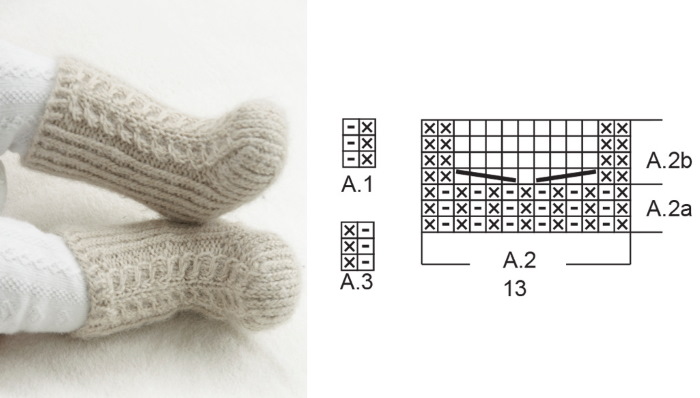
- Now, every other row, decrease 1 loop on both sides of the toe. There should be 1 loop left on each needle. They need to be pulled together and the work closed.
- The second sock is knitted in the same way.
Overalls
For beginners, it will be easier to make a jumpsuit-envelope with a hood and sleeves. You will need to take circular knitting needles No. 2. You can take any yarn.
Work begins with the hood:
- Cast on 62 stitches. Knit a rib (1x1) – 6 cm.
- The height of the hood is knitted according to the 2x2 pattern – 12 cm. The first edge loop is removed, the last one is always knitted purlwise.
- All loops are divided into 3 parts: in the central part there will be 20, and in the outer parts – 21 P.
- The central part is knitted according to the pattern, the side parts are knitted with 1 decrease in each row.
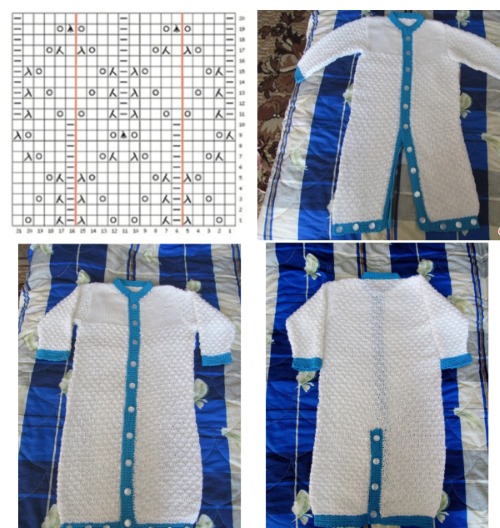
- It is necessary to add 18 loops for the side shelves.
- At the joints, you need to remove the extra loops so that they are on 46 knitting needles. Knitting pattern: 1x1. The elastic is knitted on the neck part 4 cm.
- Now it is necessary to make a calculation taking into account the raglan lines. 4 loops are allocated for them. 42 working loops remain. 14 loops are allocated for the back, 7 for the sleeves, and 7 for the front shelves.
- The fabric is knitted using a 2x2 pattern. You need to carefully count the deferred loops. Before and after the raglan line loop, a yarn over is made.
- The next row is knitted according to the pattern without throwing the thread over.
- You need to add until you get the desired sleeve size.
- In the process of knitting, the front and back panels will remain on the working circular needles, the sleeve parts are transferred to other needles or fixed with large pins.
- The working fabric from the armpit to the final elastic band is knitted without changes, 90 cm long.
- The final elastic band of the main fabric is knitted according to the 1x1 pattern – 4 cm. The last row is closed with face loops.
- Each sleeve is knitted separately on circular needles with a circle closure. The pattern of the main fabric is 2x2, finished with a rib knitting (4 cm) - 1x1.
- There are 2 hidden locks sewn into the sides of the overalls.
Dress
Hand-made things even according to the simplest scheme look interesting. For work you will need to take circular and straight knitting needles with number 3, as well as semi-cotton yarn of medium thickness.
Algorithm for performing work:
- Cast on 91 stitches onto the knitting needles.
- First, knit the neckline using the 1x1 pattern – 10 rows. The lines do not close.
- Next, the working fabric is knitted with garter stitch - 10 rows. Front side - front loops.
- The work needs to be divided into parts. 1st shelf – 23, 2nd – 45, 3rd – 23 loops.
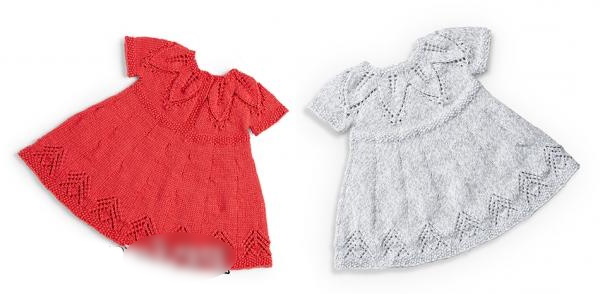
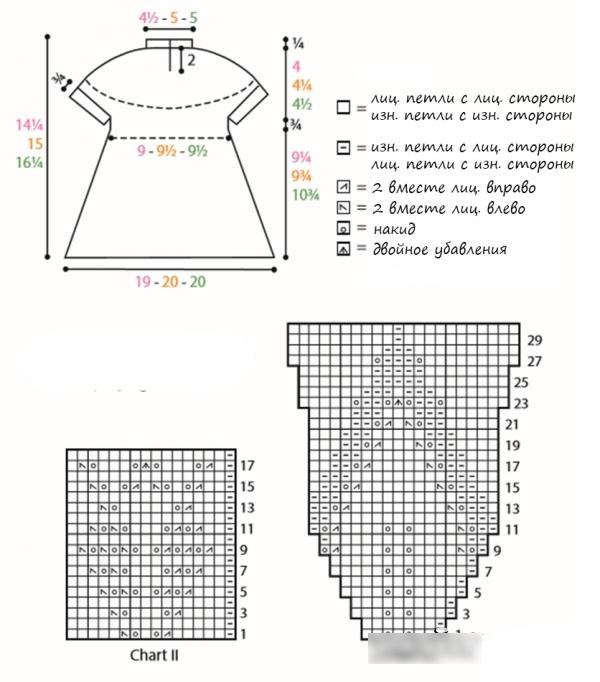
- Knitting continues with the addition of a loop in each row on the shelves 1 and 3 – 10 rows.
- You need to connect the work in a circle, knit further with an increase. There should be 220 loops on the needles.
- Knit another row without adding to secure the previously added loops.
- The canvas is divided into shelves:
- 33 loops – first back;
- 43 turns – sleeve;
- 69 loops – front;
- 43 turns – sleeve part;
- 32 loops – second back.
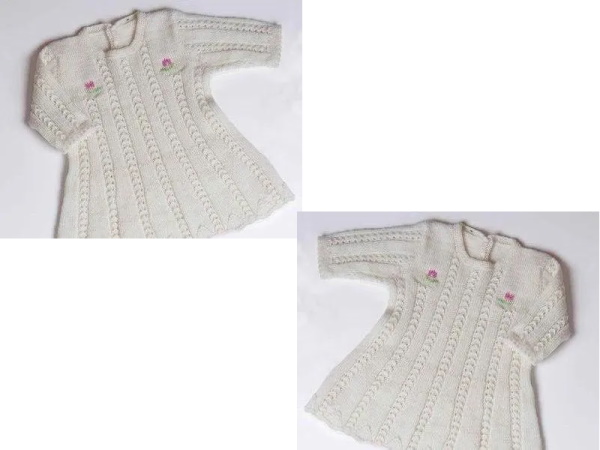

- The sleeve parts are fixed. The back and front shelves are knitted, connecting them together. There are 134 loops left on the knitting needles. 2 rows are knitted without changes.
- Every 18 loops, add 1 loop, which is knitted purlwise.
- The next row is knitted without adding according to the new pattern.
- The next row is done with additions in places where the pattern is knitted.
- The row remains unchanged.
- There should be 250 loops on the knitting needles.
- The fabric is knitted to the required length. Without additions.
- The last (closing) rows are knitted alternately: 1 purl, 1 front. A total of 5 rows.

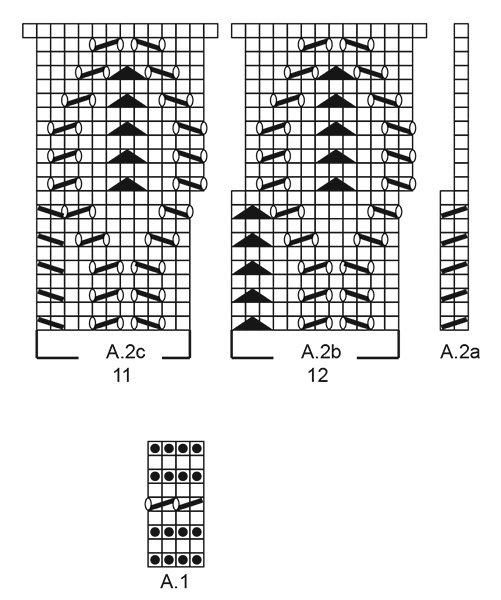
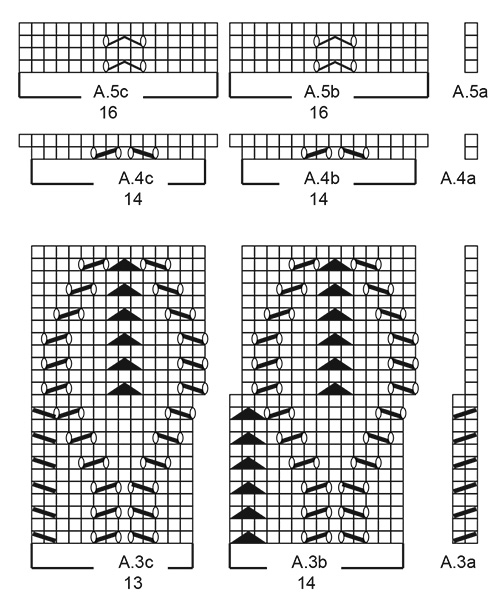
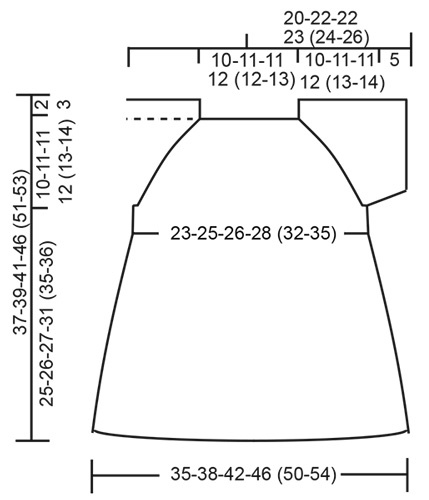
- Close the loops, secure the end of the thread.
- The sleeves are knitted without additions to a size of ¾. The work is closed in the same way - with 5 alternating rows.
Useful information! The jumper can be knitted using the same principle as the dress. The only difference is in the knitting of the neck (V-shaped or simple - circular) and the length of the sleeves. The neck, piping and bottom of the sweater are knitted using the elastic principle. And the main fabric - with face loops.
Trousers
To work you need to prepare:
- circular knitting needles No. 3.5;
- semi-wool yarn 50/50%;
- elastic band 3 cm wide.
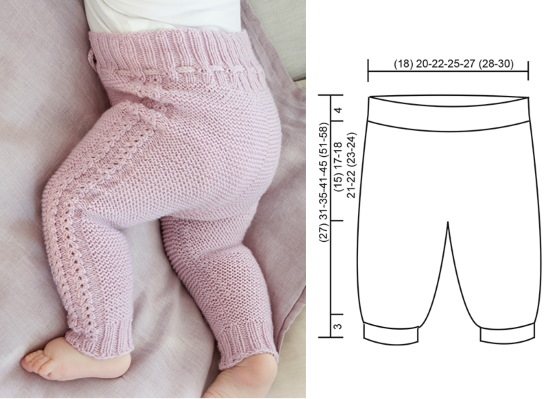
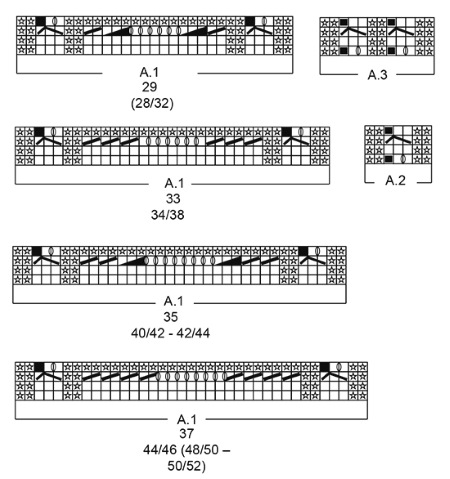
Knitting algorithm:
- You need to cast on 42 stitches onto the knitting needles.
- Knit a 2x2 elastic band – 6 rows.
- Then knit 60 rows in height, every 7 rows you need to add 2 P: 1 after the edge, 2 before the last loop in the row.
- Without closing the loops in the 1st leg, cut the thread, leaving only a 40-50 cm long end. The fabric is put aside. The 2nd leg is knitted in the same way.
- Both fabrics must be placed on 1 pair of circular knitting needles.
- Knit a row in 1 leg.
- Now you need to add 10 loops for the gusset.
- The 2nd leg is knitted to the end of the row.
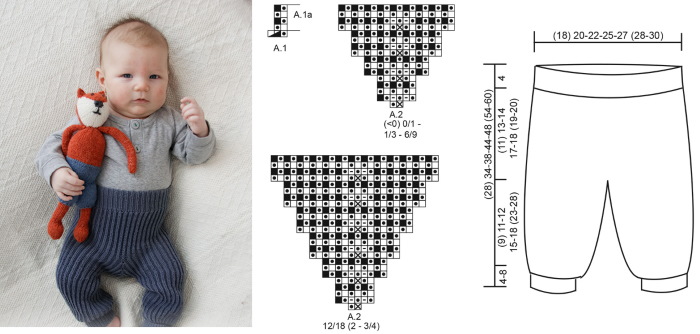
- Again, 10 loops are added.
- Now you need to knit in a circle with face loops - 2 rows.
- The next row is knitted with a decrease in the gusset loops - 1 at the beginning and 1 at the end.
- The row is knitted without changes.
- Repeat step 11. Each odd row is knitted with a decrease until there are no more loops in the gusset.
- Repeat step 12. This knitting continues in even rows.
- Now you need to knit 27 rows of face stitches in a circle.
- You need to find the middle of the upper back panel. Here you will need to install a marking ring (you can make a mark with a pin).
- From this ring, 7 front loops are knitted, a yarn is made, and the work is turned over.
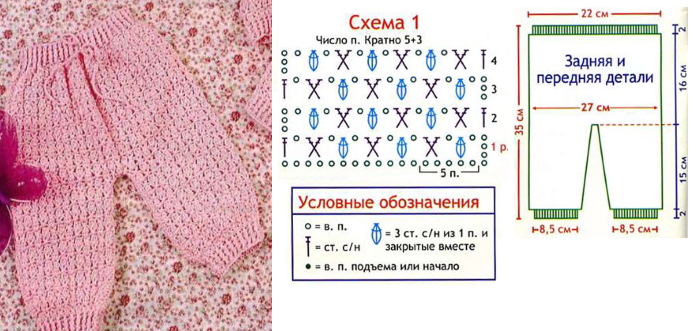
- Now you need to knit 14 purl stitches, the yarn over is knitted together with the first stitch. At the end of the row, the yarn over is made again.
- The work is turned over again and you need to knit 21 LP with a yarn over and a yarn over of the working thread at the end.
- After turning over, you need to knit 28 loops with purl stitches.
- By adding 7 stitches after each turn, 56 stitches should be knitted.
- Now you need to knit 16 rows, not forgetting to decrease the yarn over from the previous row. The work is closed.
- The elastic is sewn in, the legs and gusset are sewn together.
Sliders
The rompers are knitted in the same way as the pants, but instead of an elastic band, a drawstring is inserted. Or the front and back panels with a neck and underarm area are knitted. Loops are collected at the bottom of the legs, and a sock of the required size is knitted.
Step-by-step description of knitting clothes for children under one year old using a crochet hook
It is more convenient to knit children's things with a crochet hook, but it also requires more yarn.
Headdress
To work, you need to prepare yarn and a hook. For thin cotton thread, the tool size is chosen as No. 1.5, and for acrylic or other yarn, No. 2 or 2.5.
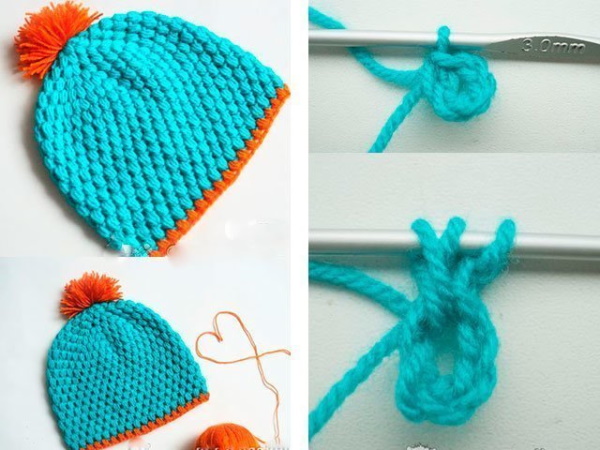

Knitting algorithm:
- Cast on 4 chain stitches, which are joined into a ring.
- From it, 8 columns with 1 yarn over in each are knitted.
- In each subsequent row the number of loops increases by 8.
- The size is selected individually. When the desired width of the product is knitted, the additions should be stopped.
- Knitting continues in a circle. The desired height of the cap is knitted.
- Now you need to tie the eyelet with the lace. To do this, mark the approximate size of the first eyelet with markers.
- In row 1, all the stitches are knitted. In each even row, 1 stitch is decreased on both sides. Odd rows are knitted without changes.
- At the end, when there is 1 loop left, the work is closed.
- The beginning and end of the second ear are determined. It is knitted similarly to the first.
- The entire hat needs to be stitched in a circle with single crochets.
- 12 pieces of yarn, 60 cm each, are pulled through the sharp part of the ears. A “braid” is woven. It is fixed at the bottom with a thread.

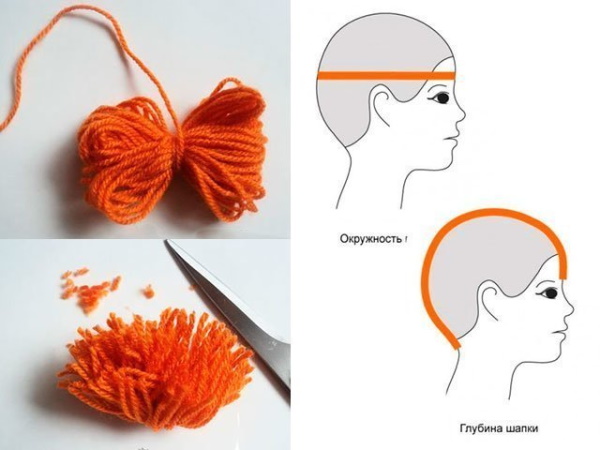
The edge of the fringe is trimmed with scissors.
Summer T-shirt
The product is knitted from 2 shelves, which are sewn together. For work you will need a thin cotton thread and a hook with the number 0.7-1.0-1.5.
Algorithm for knitting parts of a T-shirt:
- Back. 60 air loops are collected. From them, 3 rows of columns without yarn over are knitted. Then columns with 1 yarn over are knitted to the desired height of the shelf. The fabric is closed with a row of columns without yarn overs.
- Front. The front part starts the same way as the back. From the 4th row, any pattern is knitted with threads of a different color.
- Having knitted the same length as the back, the neck is knitted. For this, 9 double crochets are knitted 5-7 cm on each side.

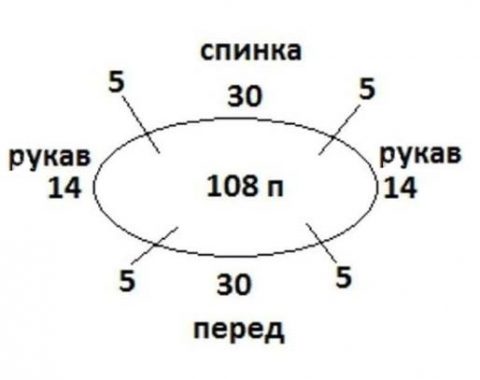
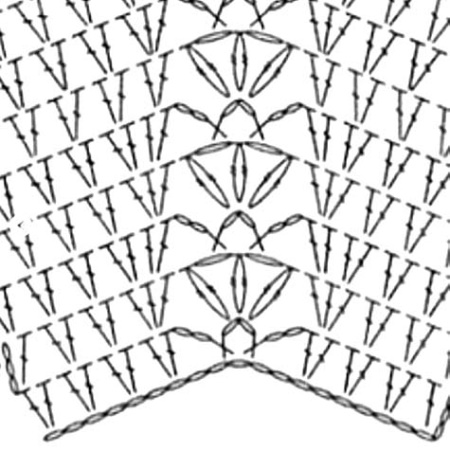
The shelves are sewn together. It is necessary to leave openings for the arms. The sleeve part and the neck are tied with a row of single crochets.
Shorts
For work you can take the same materials and tools as for making a T-shirt.
Step by step description of the process:
- For the front panel, 26 air loops are cast on for each leg.
- Odd rows are knitted with single crochet stitches, and even rows are knitted with yarn over stitches. There should be 24 rows in total.
Helpful advice! It is better to start knitting the legs with different skeins until both fragments become one whole - a shelf.
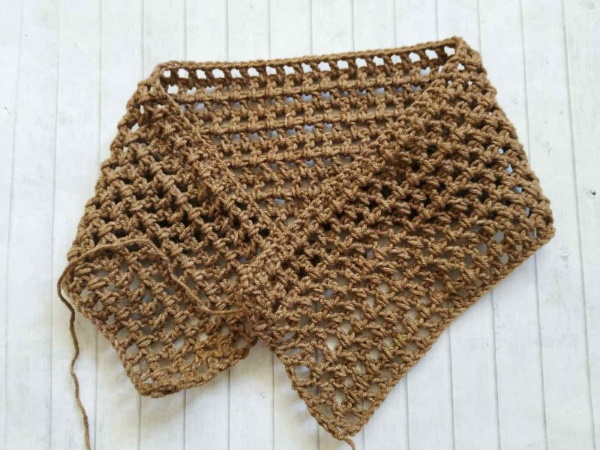
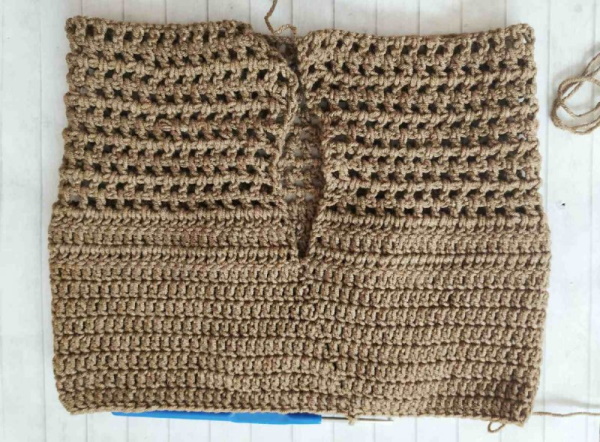
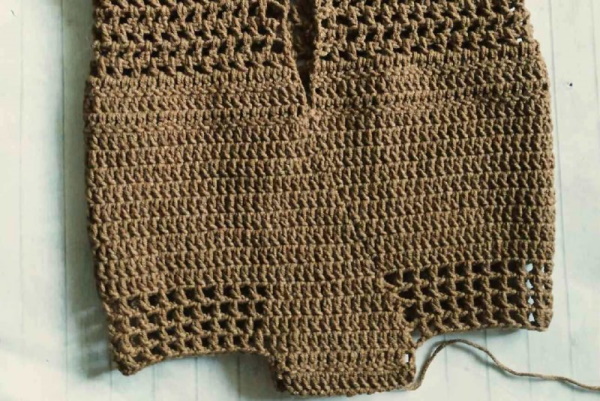
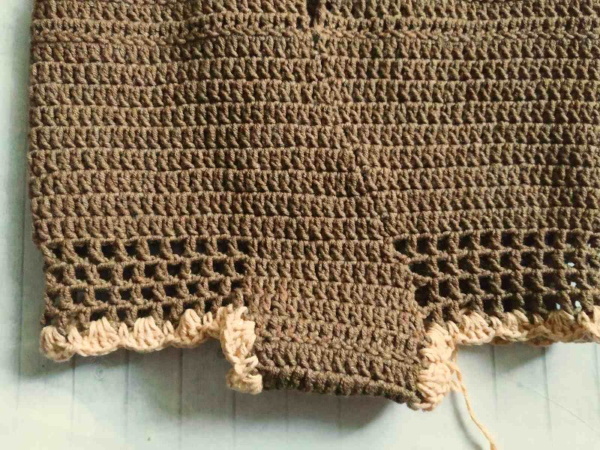
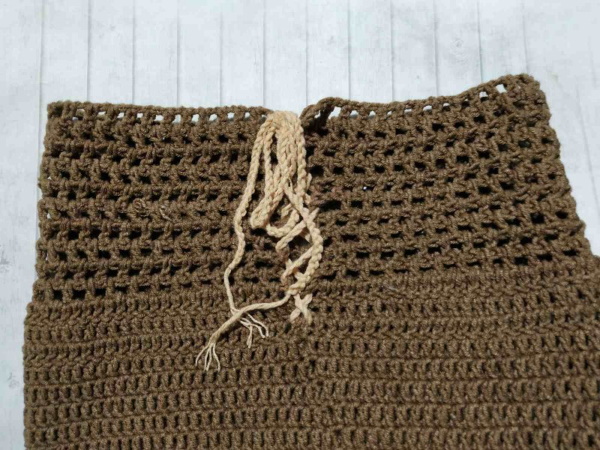
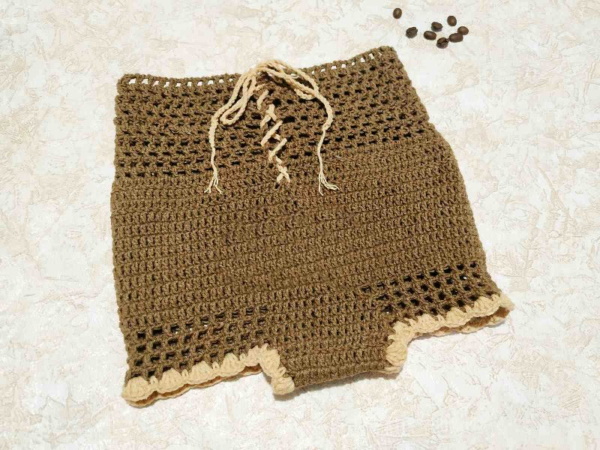
- From row 25, you need to add 1 column on one edge of each leg every other row. In total, you need to make 4 decreases on each piece.
- In row 33, 1 leg is knitted with the addition of 1 column, 2 legs are knitted with the same working thread.
- Once the shelf is assembled, rows 34 and subsequent rows are knitted according to the pattern without changes.
- Once the required height of the shelf is reached, the work is closed with a row of single crochet stitches.
- The back panel is knitted identically.
2 parts of the product are sewn together. A drawstring is inserted into the belt.
Booties
Step-by-step knitting algorithm:
- Cast on 10 chain stitches.
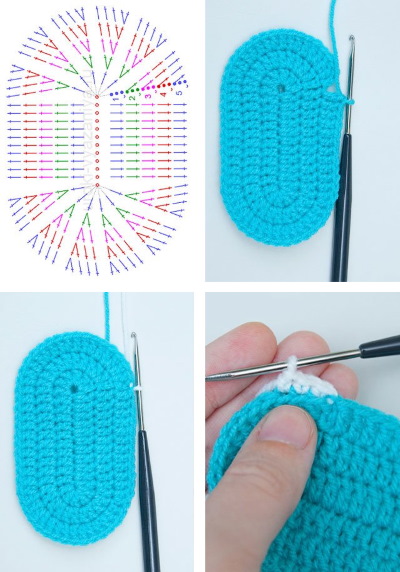
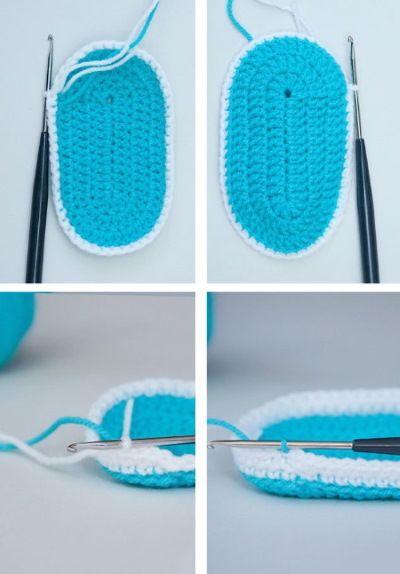

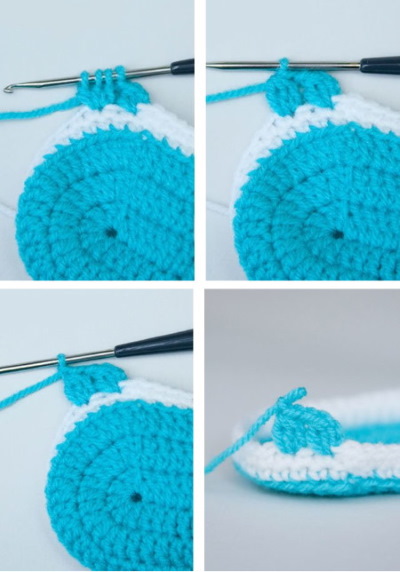

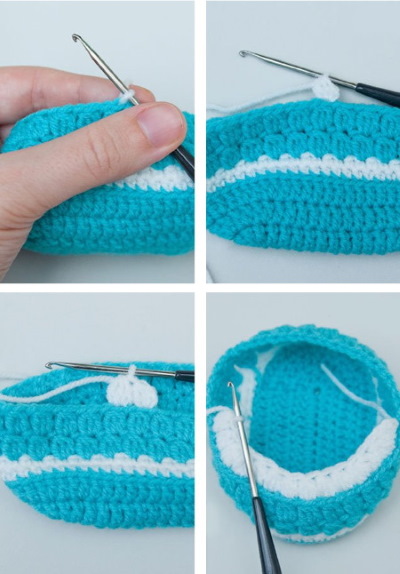
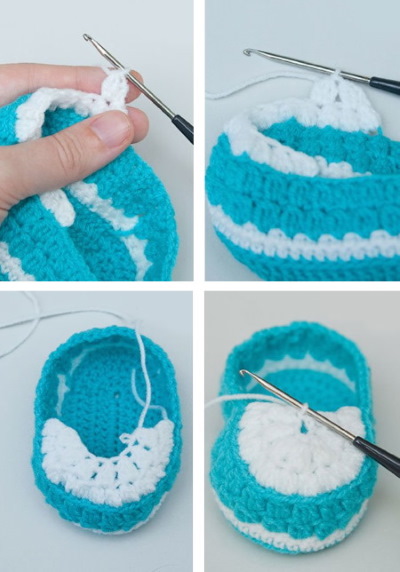
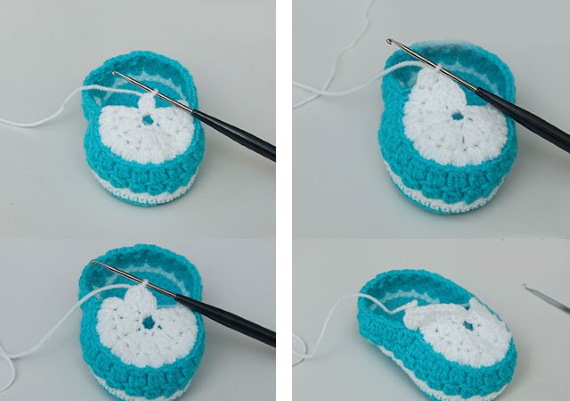
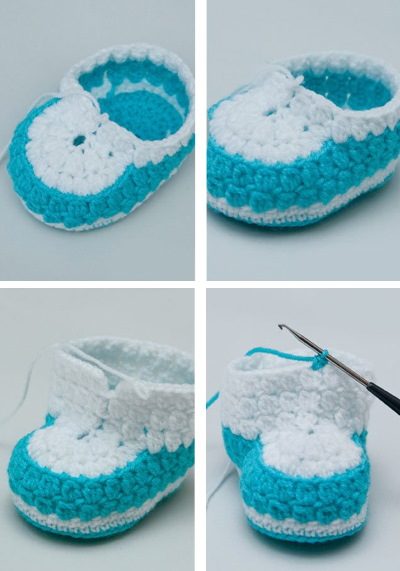
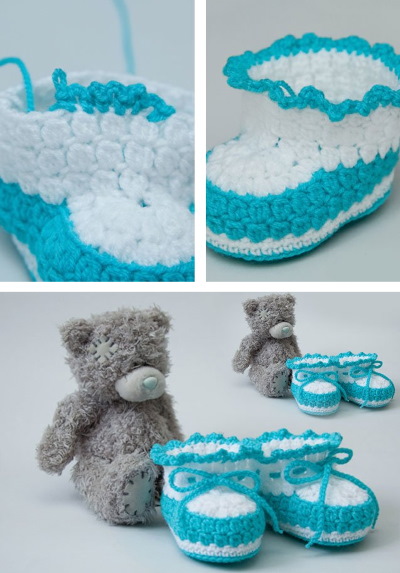
- Knit 3 rows of double crochet stitches. In the first and last loop of the row, knit 6/12/18 stitches.
- A row of single crochet stitches is knitted.
- 2 rows of yarn over stitches are knitted.
- The toe is knitted from the central part of one side to the center of the other. The fabric is gradually narrowed until 4 working columns remain. They are knitted into 1 loop.
- From this column the bootleg is knitted in a circle.
When the required height is connected, the work is closed.
Body
To make this type of clothing, it is enough to combine the knitting patterns of shorts and a T-shirt. The legs are knitted in only 2-4 rows at once with the addition of columns in the center.
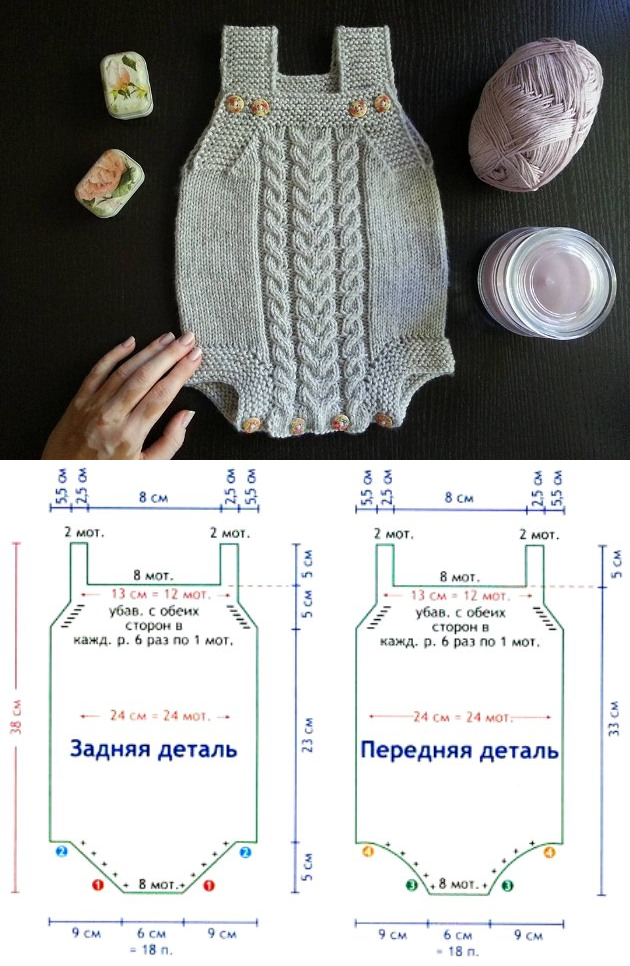
Step by step:
- The front is knitted without changes up to the neck level.
- Then the neck is knitted like a T-shirt.
- The shoulders are knitted on the back shelf.
- The product is sewn on the sides only up to the armpit level, as well as between the legs.
- The work is finished with a decorative edge if desired.
- Buttons are sewn on the front for fastening.
Socks
Knitting pattern:
- An air loop is made, from which 3 lifting loops and 11 double crochets are knitted.

- The circle closes.
- Make 3 lifting loops, 23 columns, 2 in each loop of the previous row.
- Another 5 rows are knitted without changes.
- In the new row, make 3 lifting loops, 12 single crochets.
- The work is turned over. Point 5 is repeated. In this way, you need to knit only 5 rows. The thread needs to be secured with a knot.
- Next, round the heel. Knitting begins from the 5th column, make 4 columns. After that, a thread is pulled through 2 columns, they are knitted together to the end.
- The work is unfolded. The first loop is skipped. 4 columns are knitted and the thread is again pulled through 2 columns, which are knitted together.
- This is how the heel part of the sock tapers to the end.
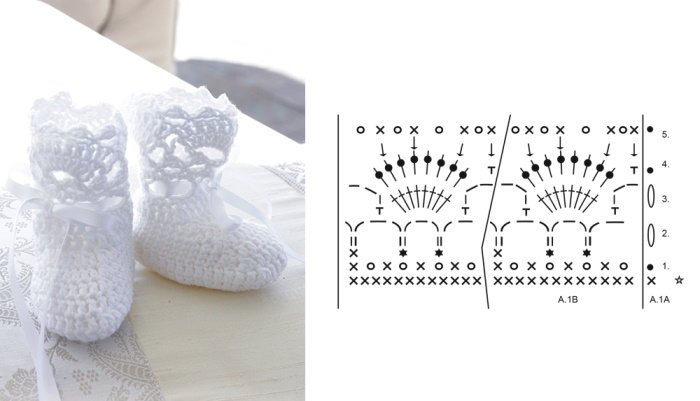
- Now knit in a circle. 4 double crochets on the heel, 6 on the side, the next 3 loops are fixed in 1 column. Then make 10 columns, 3 loops together, 6 side columns. The circle is closed.
- 28 stitches are knitted without changes – 2 circles.
- The 1x1 elastic is knitted with the same stitches, inserting the hook alternately behind the front and back sides of the loops. You need to knit 3 rows like this. The work is closed.
- The second sock is knitted in the same way.
Knitting is an interesting process. Even a single-color item, crocheted or knitted using a simple pattern, always looks advantageous against the background of similar outfits for children under one year old, bought in a store.
Video about knitting
Knitting for children under one year old - overalls:
